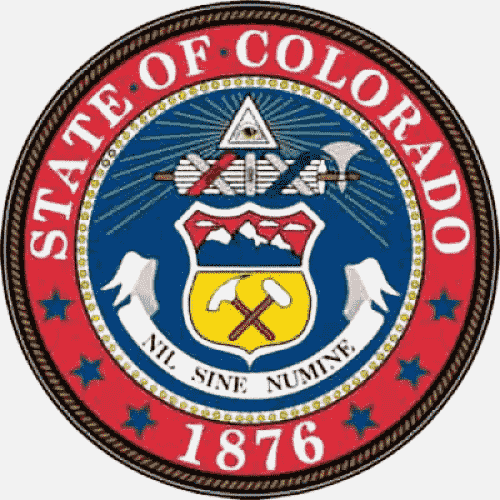 State Flag |  State Seal |
Colorado is a state in the west along the western edge of the Great Plains. It is bordered by Utah to the west, Wyoming and Nebraska to the north, Nebraska and Kansas to the east, with Oklahoma and New Mexico to the south.
- ABBREVIATION: CO
- NICKNAME: The Centennial State
- POPULATION: 5,957,493 (2024 est.)
- CAPITAL: Denver
- STATE BIRD: Lark Bunting
- STATE FLOWER: Rocky Mountain Columbine
- AREA: 104,094 sq. mi.
- TIME ZONE: Mountain
- ENTERED UNION: Aug. 1, 1876
- ALTITUDE: High, 14,440 ft. Mount Elbert
- CLIMATE: Generally hot sunny summers, cold winters.
Light rainfall, varying at different altitudes.
Heavy mountain snows.
Here is a land of superlatives. With 40 peaks rising more than 2 and a half miles above sea level, Colorado has the highest average altitude of all the mountain states.
Here too originate more major rivers than in any other state-the North and South Platte, the Arkansas, the Colorado and the storied Rio Grande-all of them flowing easterly or westerly down the opposing slopes of the Continental Divide, which zigzags on a rough north-south line through Colorado’s middle, marking the boundary of the two major drainage areas of the United States.
Ironically, Colorado is one of the driest states. West of the divide stretch the semi-arid uplands of the Colorado plateau, an area of stark beauty. Its spectacular gorge, abrupt escarpments and ancient cliff dwellings attract many thousands of tourists a year. but more important are the land’s rich deposits of minerals, petroleum and natural gas.

The Maroon Bells, Elk Mountains, Colorado
Colorado’s central location, dry climate and long periods of cloudless days have made it a center of military installations. The U.S. Military operates 7 bases in Colorado; The Air Force Academy, Cheyenne Mountain (NORAD), Fort Carson, Peterson AFB, and Schriever AFB are all located near Colorado Springs; Buckley AFB is just outside Denver, while The Pueblo Chemical Depot is in southern Colorado.
Fun Facts:
- Colorado means “colored red”.
- As protection against earthquakes or nuclear explosions, the Cheyenne Mountain Operations Center of NORAD is mounted on more than 1,300 giant springs that allow it to sway up to 12 inches in any direction.
- The longest continuous street in America is Colfax Avenue, the main east/west corridor that cuts through the state’s capital city, Denver.
- The 700-foot-high, wind-shaped sand dunes in Great Sand Dunes National Monument occupy an area that was covered by an ancient sea more than one million years ago.
- The benefits of fluorides for healthy teeth were discovered when a study determined that fluoride in the drinking water of Colorado Springs caused residents to have fewer cavities.
- The Unsinkable Molly (Margaret Tobin) Brown was a citizen of Leadville where her husband struck it rich when he found gold in 1893. She earned her nickname by helping women and children leave the Titanic before the luxury liner sank in 1912.
History:
Colorado’s history is a rich tapestry woven from diverse cultures, dramatic landscapes, and pivotal moments in American history. Long before it became a state, the land that is now Colorado was home to numerous Indigenous peoples, including the Ute, Arapaho, Cheyenne, and Ancestral Puebloans.
These groups thrived for centuries, building communities, trading, and adapting to the rugged terrain. The cliff dwellings of Mesa Verde, constructed by the Ancestral Puebloans, remain a powerful testament to their ingenuity and endurance.
Spanish explorers were among the first Europeans to enter the region in the 1500s, laying claim to the land as part of New Spain. However, it wasn’t until the early 1800s—after the United States acquired the territory through the Louisiana Purchase and later the Treaty of Guadalupe Hidalgo—that American interest in Colorado intensified.
Explorers such as Zebulon Pike and John C. Frémont mapped the area, sparking curiosity and ambition among settlers and prospectors.
The Colorado Gold Rush of 1858–1859 was a turning point in the state’s history. Thousands of fortune seekers flooded into the region, establishing mining camps that quickly grew into towns like Denver and Central City. This surge in population and economic activity led Congress to create the Colorado Territory in 1861.
Throughout the 19th century, Colorado remained a center of mining and frontier life. The arrival of the railroad in the 1870s connected Colorado to the rest of the country and accelerated its growth. Ranching and farming also took hold, especially on the plains, though settlers often clashed with Indigenous tribes. These tensions tragically culminated in violent conflicts such as the Sand Creek Massacre in 1864.
On August 1, 1876, Colorado became the 38th state, earning the nickname the “Centennial State” because it joined the Union 100 years after the signing of the Declaration of Independence. Statehood brought new opportunities, along with challenges of governance, infrastructure, and maintaining law and order in its growing towns.
The 20th century saw Colorado evolve into a more diversified economy. While mining remained important, tourism began to flourish thanks to the state’s stunning mountain scenery, ski resorts, and national parks. The military also became a major presence, with installations such as NORAD and the Air Force Academy bringing both jobs and strategic importance to the region.
In recent decades, Colorado has become known for its innovation, environmental consciousness, and booming tech industries, especially in cities like Denver, Boulder, and Colorado Springs. Its political landscape has also shifted over time, reflecting a blend of Western individualism and progressive policy.
Today, Colorado stands as a symbol of the American frontier spirit—resilient, diverse, and forward-looking. From ancient cliff dwellers and gold rush pioneers to modern innovators, the state’s history is a powerful reminder of how people and place shape one another across centuries.